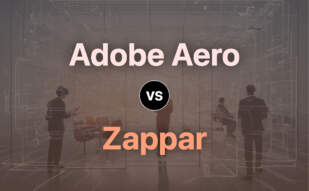If you require utmost precision in AR, with highly-advanced, AI-integrated features and object spawning capability, EasyAR is unbeatable. However, for beginners, digitals artists or educators with limited coding knowledge seeking simple AR experience creation and seamless Adobe Suite integration, Adobe Aero is a worthy choice.

Key Differences Between EasyAR and Adobe Aero
- Coding: EasyAR uses API integrations while Adobe Aero requires no coding or 3D design.
- Integration: EasyAR has cross-platform support while Adobe Aero integrates well with Adobe Creative Cloud applications.
- Pricing: EasyAR requires a subscription fee beginning at $39/month, whereas Adobe Aero is part of Adobe’s subscription service.
- Usability: Both offer a user-friendly experience, but Adobe Aero’s intuitive gesture controls make it easier for beginners.
- Support: Adobe Aero supports only iOS, whereas EasyAR has robust multi-platform support.
- Developers: EasyAR provides developer-focused features with its SDK; Adobe Aero leans towards designers.
| Comparison | EasyAR | Adobe Aero |
|---|---|---|
| Primary Use | AR platform for application development with digital animations | AR creation tool with intuitive gestures for asset placement |
| Main Features | Relocalization, persistent AR content, cloud-based, AR Cloud Image Recognition, motion tracking capabilities, AR Configurator, AR Measurement | Interactive experiences, behavioral content triggers, object motion paths |
| Release Year | 2012 | 2019 |
| Pricing | $39/month with free trial | Free with Adobe Creative Cloud subscription |
| Integration | API access | Adobe Photoshop, Illustrator, other Adobe Creative Cloud applications |
| Pros | Cross-platform support, easy integration, accurate AR features | Easy to use, compatibility with Adobe Creative Cloud suite enhances workflows |
| Cons | Unfeasible pricing, lack of optimization, limited web support | Only available to iOS devices, lacks advanced features of other AR platforms |
| Special Features | Employs AR Cloud Image Recognition, target management. High-precision 3D physical world models, auto-spawning and controls | Viewer mode for interaction, updates for stability & performance improvements |
| Latest Releases | EasyAR Mega, city-scale AR cloud solution with localization ability | Adobe planned future updates include Android device support, 3D scanning, audio, more AR platforms integration |
What Is EasyAR and Who’s It For?
EasyAR is an augmented reality (AR) platform hailing from China, designed as an adept tool for application development and digital animations. Launched in 2012, it’s blooming with engaging features such as relocalization, persistent AR content, and both local and cloud-based access. EasyAR is engineered specifically for developers and tech-minded individuals seeking to create an immersive digital experience via AR apps on iOS, Android, Windows, and macOS.
With EasyAR Sense 4.0, users are handed a considerable arsenal of algorithm components, motion tracking capabilities, and platform support. The incorporation of SenseMARS software platform provides perception intelligence, decision intelligence, and AI-empowered AR, MR content generation.

Pros of EasyAR
- Cross-platform support
- Easy integration and API access
- Accurate AR features, including relocalization, AR Measurement, and AR Occlusion
- No coding needed due to the SenseMARS software platform
- Revolutionary features like high-precision 3D world models and avatars auto-generated from photos
Cons of EasyAR
- Unfeasible pricing at $39/month
- Lack of optimization
- Limited web support
What Is Adobe Aero and Who’s It For?
Adobe Aero stands tall as an innovative AR creation tool that requires no coding or 3D design skills. It proves to be the knight in shining armor for non-technical creatives who want to leverage AR in their work. Providing seamless integration with various Adobe Creative Cloud applications, Adobe Aero is a doorway to intuitive and engaging real-world AR experiences.
This tool allows users to use intuitive gestures to place, rotate, and scale assets while offering complex and interactive experiences, behavioral content triggers, object motion paths.

Pros of Adobe Aero
- Simplifies AR development and enhances workflows
- Intuitive interface with easy asset manipulation
- Supports App Clips for faster loading experiences
- Great compatibility with Adobe Creative Cloud applications
Cons of Adobe Aero
- Only available to iOS devices
- Lacks some advanced features of other AR platforms
- Fails to open certain projects
- Currently limited to mobile app
Final Verdict: EasyAR vs Adobe Aero
In our tech-ridden universe, each AR platform holds its merit. Yet, only one can reign supreme in any context. Let’s discern:
Developers and Game Makers
In the vast expanse of development and gaming, EasyAR strikes true. Its detailed algorithm components, motion tracking features, and developer-friendly SDK offer an edge. Plus, cross-platform support ensures seamless transition across iOS, Android, Windows, and macOS,Adobe Aero falls short with its limited advanced features.

Tech Consumers
In an era where time’s valued more than money, Adobe Aero’s compatibility with Adobe Creative Cloud absolves users of technicalities, provides simplicity, speed, and interactive experiences, while EasyAR’s pricing may deter.

Business Professionals
EasyAR caters well for business and professional users, offering city-scale mapping and a SLAM framework. However, Aero’s simplicity and intuition coupled with Adobe Creative Cloud compatibility makes it an excellent choice for business professionals who want a more streamlined approach.

Your choice hinges on your context, but EasyAR stands out as a more versatile solution. Offering a range of advanced features, it outperforms Adobe Aero, which, though user-friendly, falls back on advanced options and all-platform compatibility.
Logan Bellbrook
Content writer @ Aircada with a knack for nature & AR/VR/XR. Blogging the intersection of tech & terrain.





